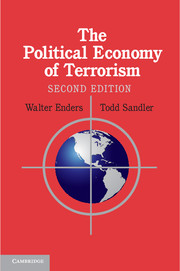Book contents
- Frontmatter
- Contents
- Tables and Figures
- Preface
- One Terrorism
- Two The Dilemma of Liberal Democracies
- Three Statistical Studies and the Dynamics of Terrorist Behavior
- Four Counterterrorism
- Five Transference
- Six International Cooperation
- Seven Hostage Taking
- Eight Terrorist Groups and Their Organization
- Nine Before and After 9/11
- Ten The Economic Impact of Terrorism
- Eleven Homeland Security
- Twelve The Future of Terrorism
- References
- Author Index
- Subject Index
Twelve - The Future of Terrorism
Published online by Cambridge University Press: 05 June 2012
- Frontmatter
- Contents
- Tables and Figures
- Preface
- One Terrorism
- Two The Dilemma of Liberal Democracies
- Three Statistical Studies and the Dynamics of Terrorist Behavior
- Four Counterterrorism
- Five Transference
- Six International Cooperation
- Seven Hostage Taking
- Eight Terrorist Groups and Their Organization
- Nine Before and After 9/11
- Ten The Economic Impact of Terrorism
- Eleven Homeland Security
- Twelve The Future of Terrorism
- References
- Author Index
- Subject Index
Summary
Despite the war on terror and the death of bin Laden, the one certainty is that terrorism will continue as a tactic associated with conflicts. As long as there are grievances, there will be conflict and, thus, terrorism. Terrorism will always be present owing to its cost-effectiveness and its favoring of the weak against the strong. A bomb that costs a mere few hundred dollars may cause hundreds of millions in damage – for example, the 1993 bombing of the north tower of the World Trade Center. Desperation and frustration are key motives for terrorism. Its cruelty can, at times, make it an end in itself.
Since the start of the modern era of terrorism in the late 1960s, terrorist experts have used current experiences and trends to predict the future of terrorism. Predictions are based on two paradigms: (i) an induction derived from recent events, and (ii) forecasts using statistical methods. Both paradigms have their shortcomings. When past experiences (attacks) are used, predictions tend to be reactive coming from an unanticipated driver – for example, the shift from leftist-based to fundamentalist transnational terrorism. Such predictions are useful until the next major unforeseen upheaval. Policy ends are better served if changing grievances, players, and tactics are recognized near their onset so that countervailing actions can be proactively engineered at the outset of change. Forecasts based on statistical techniques are less accurate as they are further projected into the future. As in the case of experienced-based predictions, a statistically fitted trend cannot foresee shocks that throw off forecasts. Trend analysis provides an “average” description that cannot identify an unusual future pattern.
- Type
- Chapter
- Information
- The Political Economy of Terrorism , pp. 345 - 362Publisher: Cambridge University PressPrint publication year: 2011



